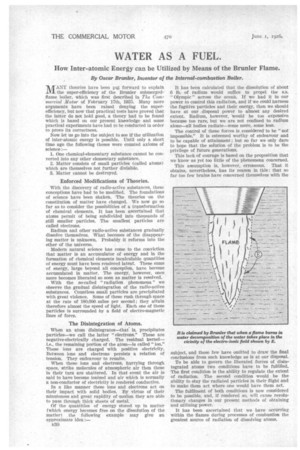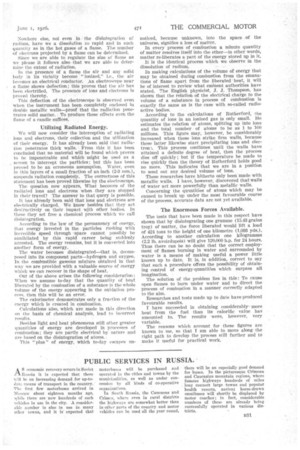WATER AS A FUEL.
Page 44

Page 45

If you've noticed an error in this article please click here to report it so we can fix it.
How Inter-atomic Energy can be Utilized by Means of the Brunler Flame.
By Oscar Brunler, Inventor of the Internal-combustion Boiler.
MANY theories have been put forward to explain the super-efficiency of the Brunler submergedflame boiler, which was first described in The Commercial Motor of February 17th, 1925. Many more arguments have been raised denying the superefficiency, but now that practical tests have proved that the latter do not hold good, a theory had to be found which is based on our present knowledge and some practical experiments have had to be conducted in order to prove its correctness.
Now let us go into the subject to see if the utilization of inter-atomic energy is possible. Until only a short time ago the following theses were counted axioms of science:— 1. One chemical-elementary substance cannot be converted into any other elementary substance.
2. Matter consists of small particles (called atoms) which are themselves not further divisible.
3. Matter cannot be destroyed.
Enforced Modifications of Theories.
With the discovery of radio-active substances, these conceptions have had to be modified. The foundations of science have been shaken. The theories on the constitution of matter have changed. We now go so far as to consider the possibilities of a transformation of chemical elements. It has been ascertained that atoms permit of being subdivided into thousands of still smaller particles. The smallest particles are called electrons.
Radium and other radio-active substances gradually dissolve themselves. What becomes of the disappearing matter is unknown. Probably it reforms into the ether of the universe.
Modern natural science has come to the conviction that matter is an accumulator of energy and in the formation of chemical elements incalculable quantities or energy must have been rendered latent. These sums of energy, large beyond all conception, have become accumulated in matter. The energy, however, once more becomes liberated so soon as matter is resolved.
With the so-called "radiation phenomena" we observe the gradual disintegration of the radio-active substances. Countless small particles are precipitated with great violence. Some of these rush through space at the rate of 180,000 miles per second; they attain therefore almost the speed of light. Each one of these particles is surrounded by a field of electro-magnetic lines of force.
The Disintegration of Atoms.
When an atom disintegrates—thaf is, precipitates particles—we call the latter "electrons." These are negative-electrically charged. The residual kerneli.e., the remaining portion of the atom—is called "ion." These ions are charged with positive electricity. Between ions and electrons persists a relation of tension. They endeavour to reunite.
When these ions and electrons, hurrying through space, strike molecules of atmospheric air then these in their turn are shattered. In that event the air is said to have become ionized and air which is normally a non-conductor of electricity is rendered conductive.
In a like manner these ions and electrons act on their impact with solid bodies. By virtue of their minuteness and great rapidity of .motion they are able to pass through thick sheets of metal.
Of the quantities of energy stored up in matter (which energy becomes free on the dissolution of the matter) the following example may give an approximate idea :— B30 It has been calculated that the dissolution of about 6 lb. of radium would suffice to propel the S.S. " Olympic " across the ocean. If we had it in our power to control this radiation, and if we could harness the fugitive particles and their energy, then we should have at our disposal power to almost any desired extent. Radium, however, -would be too expensive because too rare, but we are not confined to radium alone—all bodies radiate—some more, some less.
The control of these forces is considered to be "not impossible." It is esteemed worthy of endeavour and to be capable of attainment ; but so far we only dare to hope that the solution of the problem is to be the privilege of future generations.
This lack of courage is based on the proposition that we know as yet too little of the phenomena concerned.
This assumption is, however, erroneous. That it obtains, nevertheless, has its reason in this: that so far too few brains hare concerned themselves with the subject, and these few have omitted to draw the final conclusions from such knowledge as is at our disposal.
To be able to govern the liberated forces of disintegrated atoms two conditions have to be fulfilled. The first condition is the ability to regulate the extent of radiation. The second condition would be the ability to stay the radiated particles in their flight and to make them act where one would have them act.
The fulfilment of both conditions is now considered to be possible, and, if rendered so, will cause revolutionary changes in our present methods of obtaining and utilizing power.
It has been ascertained that we have occurring within the flames during processes of combustion the greatest source of radiation of dissolving atoms. Nowhere else, not even in the disintegration of radium, have we a dissolution so rapid and in such quantity as in the hot gases of a flame. The number of electrons projected by a flame can be determined.
Since we are able to regulate the size of flame as we please it follows also that we are able to determine the extent of radiation.
In the presence of a flame the air and any solid body in its vicinity become "ionized," i.e., the air becomes an electrical conductor. An electroscope near a flame shows deflection; this proves that the air has been electrified. The presence of ions and electrons is proved thereby.
This deflection of the electroscope is observed even when the instrument has been completely enclosed in double metallic walls—proof that the radiation penetrates solid matter. To produce these effects even the flame of a candle suffices.
Utilizing Radiated Energy.
We will now consider the interception of radiating ions and electrons, their collection and the utilization of their energy. It has already been said that radiation penetrates thick walls. , From this it has been concluded that no material will be found which proves to be impenetrable and which might be used as a screen to intercept the particles; but this has been proved to be an erroneous assumption. Water, even in thin layers of a small fraction of an inch (2-3 mm.), suspends radiation completely. The correctness of this statement has been proved likewise by the electroscope. The question DOW appears, What becomes of the radiated ions and electrons when they are stopped in their travel? The answer to that query is possible.
It has already been said that ions and electrons are electrically charged. We know besides that they act destructively on their impact with other bodies. In these they set free a chemical process which we call disintegration.
According to the law of the permanency of energy, that energy invested in the particles rushing with incredible speed through •sPace cannot possibly be annihilated by this rapid career being suddenly arrested. The energy remains, but it is converted into another form of energy.
The water becomes disintegrated—that is, decomposed into its component parts—hydrogen and oxygen. In the combustible gaseous mixture obtained in that way we are provided with a valuable source of energy which we can recover in the shape of heat.
Out of the above arises the following consideration : When we assume to-day that the quantity of heat liberated by the combustion of a substance is the whole volume of the energy appearing in the oxidation process, then this will be an error.
The calorimeter demonstrates only a fraction of the energy which is created in combustion.
Calculations also, which are made in this direction on the basis of chemical analysis, lead to incorrect resui (s.
Besides light and heat phenomena still other greater quantities of energy are developed in processes of combustion; they are partly electrical by nature and are based on the disintegration of atoms...
This " plus " of energy, which to-day escapes on noticed, because unknown, into the space of the universe, signifies a loss of matter.
In every process of combustion a minute quantity of matter resolves itself into the ether—in other words, matter re-liberates a part of the energy stored up in it.
It is the identical pkocess which we observe in the dissolution of radium.
In making calculations of the volume of energy that may be obtained during combustion from the emanations of flame apart from the liberated • heat, it will be of interest to review what eminent authorities have stated. The English physicist, J. J. Thompson, has shown that the relatioa.of the electrical charge to the volume of a substance in process of combustion is exactly the same as is the case with so-called radioactive bodies.
According to the calculations of Rutherford, the quantity of ions in an ionized gas is only small. He estimates the relation of atoms, splitting up into ions and the tOtal number of atoms to be as 1 to 100 millions. This figure may, however, be considerably increased when these ions strike firm walls, because these latter likewise start precipitating ions and electron. This process continues until the walls have attained a definite degree of heat, then the process dies off quickly; but if the temperature be made to rise quickly then the theory of Rutherford holds good no more. This indicates that we are in a position to send out any desired volume of ions.
These researches have hitherto only been made with metallic walls. I have, however, discovered that walls of water act more powerfully than metallic walls.
Concerning the quantities of atoms which may be caused to break up under the most favourable course of the process, accurate data are not yet available.
The Enormous Forces Available.
The tests that have been made in this respect have shown that by disintegrating one gramme (15.43 grains troy.) of matter, the force liberated would lift a load of 424 tons to the height of one kilometre (1,093 yds.). According to another calculation one kilogramme (2.2 lb. avoirdupois) will give 120,000 h.p. for 24 hours. Thus there can be no doubt that the correct employment of flames burning in water and surrounded by water is a means of making useful a power little known up to date. It is, in addition, correct to say that such a procedure offers the possibility of obtaining control of energy-quantities which surpass all imagination.
The solution of the problem lies in this: To cause open flames to burn under water and to direct the process of combustion in a manner correctly adapted to the aira.
Researches and tests made up to date have produced favourable results.
I have succeeded in obtaining considerablymore heat from the fuel than its calorific value has amounted to. The results were, however, very variable.
• The reasons which account for these figures are known to me, so that I am able to move along the right path to develop the process still farther and to make it useful for practical work.


























































